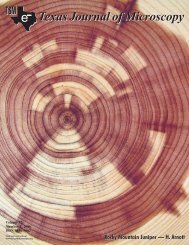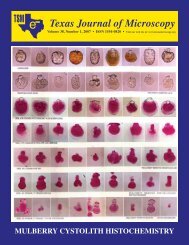Texas Journal of Microscopy - Texas Society for Microscopy
Texas Journal of Microscopy - Texas Society for Microscopy
Texas Journal of Microscopy - Texas Society for Microscopy
You also want an ePaper? Increase the reach of your titles
YUMPU automatically turns print PDFs into web optimized ePapers that Google loves.
esearch. True as that is, like most curricula, course work generally<br />
takes up a great share <strong>of</strong> the student’s time. I found out, talking to<br />
Dr. Foster, that I was also lacking in physics and organic chemistry;<br />
and that I needed to take plant physiology over (again my appeal<br />
was ignored); these were courses that must be taken. I greatly<br />
enjoyed the physics labs and lectures. You may remember (Part<br />
II) I mentioned my high regard <strong>for</strong> the teaching <strong>of</strong> my physics<br />
pr<strong>of</strong>essor, Dr. Harvey White. I found that the organic chemistry<br />
course was really bad, horribly bad, an abomination; my pr<strong>of</strong>essor<br />
just didn’t cut it. Plant physiology was pretty much a repetition <strong>of</strong><br />
what happened at USC.<br />
As my second semester started, I learned that there was a job open<br />
in the U.C. Berkeley Herbarium. I applied and was given the position.<br />
At that time it was not obvious what a great opportunity it was. The<br />
U.C. Herbarium is the largest herbarium west <strong>of</strong> the Mississippi; at<br />
that time it occupied 9 floors in the five story Life Science Building,<br />
the additional floors were designed to increase the space used <strong>for</strong><br />
storing specimens. Over time, I met many people who worked in<br />
and/or made the U.C. Berkeley Herbarium their “home.” The variety<br />
<strong>of</strong> people was large, interesting and included pr<strong>of</strong>essors, curators,<br />
visiting pr<strong>of</strong>essors, students, lay visitors, herbarium staff, graduate<br />
and undergraduate students, etc. I worked <strong>for</strong> Annetta Carter, who<br />
worked under the Herbarium Director, Dr. Herbert Mason.<br />
Annetta Carter was the local administrator and she kept things<br />
organized and moving. Among many things, Annetta taught me<br />
to print herbarium sheet labels; it took some considerable ef<strong>for</strong>t<br />
on her part, as neither spelling nor printing were my <strong>for</strong>te. After<br />
Annetta developed some confidence in me she taught me to sort and<br />
file herbarium sheets. Filing is especially important since once a<br />
specimen is misfiled it can be missing <strong>for</strong> some time (it’s not unlike<br />
the problem <strong>of</strong> misfiling library books). John Ingram, a friend from<br />
USC, who graduated a year ahead <strong>of</strong> me, was a Ph.D. student who<br />
also worked in the herbarium. John taught me the complicated<br />
protocol <strong>for</strong> wrapping packages <strong>of</strong> specimens <strong>for</strong> shipment; the<br />
wrapping paper, string and knots were all strictly defined.<br />
Figure 9. Dr. Adriance S. Foster visits with John J. and<br />
Howard J. Arnott in our home at 2438 Hilgard, Berkeley<br />
in 1958. Photo by Jean Arnott.<br />
John, in addition to sometimes supervising my filing, taught me<br />
a lot about plant taxonomy, his major interest. John and I went on<br />
a field trip to Baja Cali<strong>for</strong>nia, Cali<strong>for</strong>nia, Arizona and northern<br />
Mexico in 1955 to collect material <strong>for</strong> John’s dissertation. The brand<br />
new U.C. Berkeley station wagon John checked out from the motor<br />
pool, had most <strong>of</strong> its paint removed or damaged during a sand storm<br />
in southern Cali<strong>for</strong>nia. This situation was very difficult <strong>for</strong> John<br />
because he thought that the University would charge him <strong>for</strong> the<br />
damage. They didn’t!<br />
The following herbarium anecdote may be <strong>of</strong> interest: several times<br />
I watched the famous paleobotanist, Dr. Ralph Chaney, at work in the<br />
herbarium. Dr. Chaney had an illustrious career and was justifiably<br />
famous; he coined the popular name “Dawn Redwood” <strong>for</strong> Metasequoia<br />
glyptostroboides. He <strong>of</strong>ten worked in the herbarium during the time I<br />
was filing specimens and he paid absolutely no attention to my activities.<br />
He would come in with a box <strong>of</strong> fossils (rocks), and would go from case<br />
to case, and sheet to sheet, until he found some plant leaf or stem that<br />
resembled his current “rock”. When he found something “pleasing,” he<br />
wrote the name down on a small piece <strong>of</strong> paper and attached it to the<br />
rock (fossil). Se la paleobotanic!<br />
The “herbarium people” always observed “tea time” in the<br />
afternoon. No matter who you were or where you worked everyone<br />
went to tea in the afternoon. At tea time you were able to meet<br />
people, including your colleagues, visitors and pr<strong>of</strong>essors. I spent<br />
one and a half happy years in the herbarium. Retrospectively, it was<br />
time very well spent; it gave me a better understanding <strong>of</strong> plants<br />
and opened my eyes to the wide variation in plants and in people<br />
who study them. The herbarium experience has always been a<br />
useful resource in my teaching.<br />
By my second year (1954), I had chosen Dr. Adriance S. Foster<br />
as major pr<strong>of</strong>essor (Figs. 8, 9). Although I had made a good start<br />
on the embryology <strong>of</strong> Yucca while at USC, I spent a great deal <strong>of</strong><br />
additional ef<strong>for</strong>t at Berkeley refining my understanding <strong>of</strong> embryo<br />
sac development in the four Cali<strong>for</strong>nia species, Y. whipplei, Y.<br />
brevifolia, Y. Schidigera, and Y. baccata. These studies were included<br />
in my dissertation, however, they were never separately published (A<br />
real mistake!). Many years later I listened to a presentation on the<br />
embryology <strong>of</strong> Y. whipplei by Dr. Maynard F. Moseley. After the paper<br />
I told him about my dissertation and we agreed that we would jointly<br />
publish our story. I visited him at U.C. Santa Barbara and we went<br />
over each other’s figures and he accompanied me on a Y. whipplei<br />
collecting trip. Somehow we never got the publication done.<br />
Eventually, my dissertation involved many aspects <strong>of</strong> Yucca<br />
research. The most comprehensive part dealt with the structure and<br />
development <strong>of</strong> yucca seeds. Almost from the beginning <strong>of</strong> my time at<br />
Berkeley I was engaged in collecting, processing and viewing <strong>of</strong> yucca<br />
materials. The boundary that should have been drawn around my<br />
research on yucca seemed to have no restrictions. The research I did is<br />
documented in my dissertation and ranges from taxonomy, cytology,<br />
morphology to anatomy. Much <strong>of</strong> the breadth <strong>of</strong> my exploration arose<br />
from an unlikely source—the language examinations. We were<br />
required to translate passages in German and French. Foster gave<br />
the exam on French and I passed it without a problem.<br />
The German exam, on the other hand, was given by Johannes<br />
Proskauer, a young pr<strong>of</strong>essor (in his early 30’s) with a German<br />
background. On my first two tries, I failed his German examination as<br />
given by Proskauer. When I found the third exam stuck in my mailbox<br />
and realized that I had failed it too, I was ready to fight. If Proskauer<br />
and I had met that afternoon, it would have unquestionably ended my<br />
college career. By the next day, I had cooled <strong>of</strong>f, but I still believed<br />
he “had it in <strong>for</strong> me” (how <strong>of</strong>ten have you heard that?). The point<br />
<strong>of</strong> writing about this is that the German exam extended my stay in<br />
Berkeley by a couple <strong>of</strong> years. Between the exams, I continued to work<br />
on yucca research (that was fun) and on German (that was not fun).<br />
Finally, to end this absurd situation, Foster decided to give me<br />
the German exam himself; I passed it on the first attempt. I believe<br />
that even then in the mid 50’s these language requirements were<br />
an anachronism. Of course, now language requirements are not<br />
generally a part <strong>of</strong> Ph.D. programs. This is true because most <strong>of</strong><br />
international scientific community began publishing in English<br />
in the 1950’s. For better or not, I never used either German or<br />
French very much in my research. My first published paper came<br />
Autobiography continued on page 69<br />
Tex. J. Micros. 37:2, 2006<br />
67




